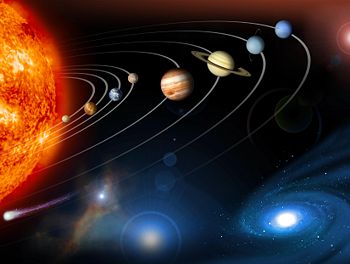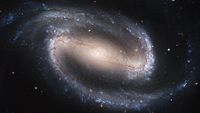Astronomy: The Biblical View
| Student files |
 Astronomy is the scientific study of matter in
outer space with the goal of determining or measuring properties of
distant objects, such as distances, positions, dimensions,
distribution, magnitudes, motion, composition, physical condition,
energy, evolution, and the causes of their various phenomena. Astronomers research
the contents of the Universe from
the level of elementary particles (with masses of 10−30 kg)
to the largest superclusters of galaxies (with
masses of 1050 kg).[1] Creation
Astronomy differs only in that it attempts to
explain stellar phenomena from the presupposition that celestial
bodies were created by God.
Most creationists also draw from religious texts like the Bible for
insight.
Astronomy is the scientific study of matter in
outer space with the goal of determining or measuring properties of
distant objects, such as distances, positions, dimensions,
distribution, magnitudes, motion, composition, physical condition,
energy, evolution, and the causes of their various phenomena. Astronomers research
the contents of the Universe from
the level of elementary particles (with masses of 10−30 kg)
to the largest superclusters of galaxies (with
masses of 1050 kg).[1] Creation
Astronomy differs only in that it attempts to
explain stellar phenomena from the presupposition that celestial
bodies were created by God.
Most creationists also draw from religious texts like the Bible for
insight.
At present, though astronomy continues to make important discoveries, is still in its infancy as regards gaining depth of understanding. Some would argue that it has many errant notions. (See astronomy quotes)
Important branches in this discipline include astrophysics and cosmology.
-
- Astrophysics deals with the physics of stellar phenomena.
- Cosmology is the study of the origin, current state, and future of the cosmos.
Astrophysical measurements and analysis are used to understand the cosmological history, structure, and constituent dynamics of our universe.
Contents
[hide]Age of the Universe
- Main Article: Cosmic chronology
The Bible explicitly dates the universe as being the same age as the Earth and just over 6000 years old. In fact, according to the Bible, all other celestial bodies are slightly younger than the Earth. At the moment the Earth was created there were no other planets, stars, comets, or other such bodies in the universe. None of these came into existence until the fourth day of the Creation Week (See: Genesis Chapter 1). There is indeed much evidence to support the contention that our solar system, galaxies and even that the entirety of the universe is very young.
In contrast, secular scientists date the universe as being approximately 13.7 billion years using standard cosmologies.[2] The universe is believed to have begun with a cosmic inflation known as the Big Bang, which is then followed by the formation of stars, planets, and galaxies. Based on this chronology the Earth is believed to have formed after our Sun and is dated to be near 4.6 billion years old.
Astronomical object
Galaxies
- Main Article: Galaxy
A galaxy is a large group of stars and interstellar gas and dust moving around a common center of gravity. The term galaxy comes from the Greek root galakt, which means "milk" (a reference to our own Milky Way). There are probably more than one hundred billion (1011) galaxies in the observable universe, which average near one hundred billion stars each. Galaxies range in size from dwarfs with as few as ten million (107) stars up to giants with one trillion (1012) stars.[3]
Stars
- Main Article: Star
A star is a body in space of great size that produces prominent amounts of heat and light. Stars are composed of incredibly hot plasma and are classified by size and intensity. The sun is conventionally considered a star, although the creation account of Genesis mentions the stars secondarily after recording the creation of the sun on day four. Evolutionists assert that star formation or change must take millions of years to take place, however star alteration has been observed in just a few years.[4] These still widely held views of modern science and are actually founded in theories of stellar evolution that are primarily based on clues obtained from studies of the stellar spectra related to luminosity.
Planets
- Main Article: Planet
The word planet comes from the Greek word πλανήτης (planetes) which is derived from the word πλάνης (planes)meaning "wanderer." [5] Originally the term was applied to any object that moved in the sky including stars. However, as a more complete picture of our universe emerged from the work of astronomers, the classification of a planet became more specific. In our solar system there are eight definite planets: Mercury, Venus, Earth, Mars, Jupiter, Saturn, Uranus and Neptune. In 2006 the International Astronomical Union (IAU) demoted Pluto from its classification as a planet to dwarf planet because it did not conform to recently established criteria.
Dwarf planets
- Main Article: Dwarf planet
A dwarf planet is any celestial body that meets all the criteria for being a planet, except one: it does not "clear the neighborhood" of its orbit of all foreign-object debris. Currently, Eris, Pluto, and the former asteroid Ceres fall into this category. The IAU invented the category of "dwarf planet" following the discovery of Eris, a body larger even than Pluto but which, like Pluto, had not cleared its orbit of debris.
Moons
- Main Article: Moon
A moon is a natural satellite that orbits a planet or dwarf planet. The body known as The Moon is the particular object in orbit around the Earth, but nearly 200 other moons are known to exist in our solar system, in orbit around six of the eight planets and two of the dwarf planets (Pluto and Eris). For example, Jupiter has more than sixty satellites, including its four largest, the Galilean moons. The Earth's moon is the brightest object in the night sky, reflecting the light from the sun. The moon is the only astronomical body other than Earth ever visited by human beings.
History
Greek
One of the most powerful creations of Greek science was the mathematical astronomy created by Hipparchus in the second century B.C. and given final form by Ptolemy in the second century A.D. Ptolemy's work was known in the Middle Ages through imperfect Latin versions. In fifteenth-century Italy, however, it was brought back to life. George Trebizond, a Cretan emigre in the curia, produced a new translation and commentary. These proved imperfect and aroused much heated criticism. But a German astronomer, Johannes Regiomontanus, a protege of the brilliant Greek churchman Cardinal Bessarion, came to Italy with his patron, learned Greek, and produced a full-scale "Epitome" of Ptolemy's work from which most astronomers learned their art for the next century and more. Copernicus was only one of the celebrities of the Scientific Revolution whose work rested in large part on the study of ancient science carried out in fifteenth-century Italy.[6]
Cosmic fine-turning
- Main Article: Cosmic fine-tuning
There is abundant evidence that every little aspect of life is perfectly placed in order to sustain life. If altered even by the slightest amount, life would not be able to exist. How could something so specific have happened by chance? There are multitudes of examples of things so finely tuned, such that if even a single element were different, life could not exist.
| “ | Mathematical numbers underpin the fabric of our universe - not just atoms, but galaxies, stars and people. The properties of atoms - their sizes and masses, how many different kinds there are, and the forces linking them together - determine the chemistry of our everyday world. The very existence of atoms depends on forces and particles deep inside them. The objects that astronomers study - planets, stars, and galaxies - are controlled by the force of gravity. And everything takes place in the arena of an expanding universe, whose properties were imprinted into it at the time of the initial Big Bang.[7] | ” |
To take one example, the number 1,000,000,000,000,000,000,000,000,000,000,000,000, is the measurement of the strength of the electrical forces which bond atoms together divided by the force of gravity between them. If this number were smaller by merely a few zeroes there would be a universe and creatures vastly smaller in size, and no time for biological evolution to even take place.[8] The exquisite mathematical fine-tuning of this kind has impressed upon physicists, cosmologists and astrophysicist the seemingly impossibility of the universe to be hospitable for human existence by pure chance, even within a speculative multiverse ensemble. (See: Intelligent Design)
The argument for the existence of God from the fine-tuning of the universe states:
- The fine-tuning of the universe is due either to physical necessity, chance or design.
- It is not due to physical necessity or chance.
- Therefore, it is due to design.[9]
Biblical References to the Heavens
- Main Article: Biblical astronomy
The Bible speaks of three heavens: the first heaven is the atmosphere, the third heaven is the place of the direct presence of God and is possibly non-physical or at least outside the bounds of the physical universe, and the second heaven is the physical universe beyond the earth's atmosphere, the realm of astronomy.
The heavens are the only portion of the creation credited with proclaiming God's righteousness.
The heavens declare his righteousness, for God himself is judge! [Selah] Psalm 50:6 (NASB)
The heavens proclaim his righteousness; and all the peoples behold his glory. Psalm 97:6 (NASB)
By the Word and Hand of God
By the word of the LORD the heavens were made, and all their host by the breath of his mouth. Psalm 33:6 (NASB)
Of old thou didst lay the foundation of the earth, and the heavens are the work of thy hands. Psalm 102:25 (NASB)
And again: Thou, Lord, didst found the earth in the beginning, and the heavens are the work of thy hands; Hebrews 1:10 (NASB)
They deliberately ignore this fact, that by the word of God heavens existed long ago, and an earth formed out of water and by means of water, II_Peter 3:5 (NASB)
God Stretched-out the Heavens
It is he who sits above the circle of the earth, and its inhabitants are like grasshoppers; who stretches out the heavens like a curtain, and spreads them like a tent to dwell in; Isaiah 40:22 (NASB)
Thus says God, the LORD, who created the heavens and stretched them out, who spread forth the earth and what comes from it, who gives breath to the people upon it and spirit to those who walk in it: Isaiah 42:5 (NASB)
Thus says the LORD, your Redeemer, who formed you from the womb: "I am the LORD, who made all things, who stretched out the heavens alone, who spread out the earth--Who was with me? Isaiah 44:24 (NASB)
and have forgotten the LORD, your Maker, who stretched out the heavens and laid the foundations of the earth, and fear continually all the day because of the fury of the oppressor, when he sets himself to destroy? Isaiah 51:13 (NASB)
An Oracle The word of the LORD concerning Israel: Thus says the LORD, who stretched out the heavens and founded the earth and formed the spirit of man within him: Zechariah 12:1 (NASB)
Do not be Dismayed by the Heavens
Thus says the LORD: "Learn not the way of the nations, nor be dismayed at the signs of the heavens because the nations are dismayed at them, Jeremiah 10:2 (NASB)
Not made of things which are visible
. The worlds were prepared by the word of God and God did not depend on things which are visible to create the visible things that we see today. God's word asserts numerous realities that are not discernible to the natural senses. These include spirits, angels, demons, and God Himself.By faith we understand that the worlds were prepared by the word of God, so that what is seen was not made out of things which are visible. Hebrews 11:3 (NASB)
Astronomers
Creationist
- Gerardus Bouw
- Tycho Brahe
- John Byl
- Nicolaus Copernicus
- Don DeYoung
- Danny Faulkner
- Galileo Galilei
- Guillermo Gonzalez
- William Herschel
- Johannes Kepler
- Jason Lisle
- Andrew Rigg
- Hugh Ross
- Ron Samec
Secular
Astronomy News
- Speck of Interstellar Dust Obscures Glimpse of Big Bang A new analysis has confirmed that the BICEP signal was mostly, if not all, stardust, and that there is no convincing evidence of inflation. New York Times. January. 30, 2015.
- Star Trek-like invisible shield found thousands of miles above Earth Shield blocks so-called "killer electrons," which whip around the planet at near-light speed and have been known to threaten astronauts, fry satellites and degrade space systems during intense solar storms. Phys Org, November 26, 2014.
- Cosmic Case of Missing Stars Baffles Scientists A massive population of stars is missing, and scientists are stumped as to where it could be. Live Science, November 24, 2014.
- Bad News for the Big Bang: Secular Scientists Claim Universe Shouldn’t Exist Nearly two years after the highly-publicized discovery of the elusive ‘God Particle,’ scientists have determined that the current Big Bang model cannot account for the existence of the universe. Christian News Network, June 24, 2014.
- Big Bang blunder bursts the multiverse bubble Premature hype over gravitational waves highlights gaping holes in models for the origins and evolution of the Universe Nature, June 3, 2014.
- Universe is Not Expanding After All, Scientists Say New evidence was based on detailed measurements of the size and brightness of hundreds of galaxies by a team of astrophysicists Lawrenceville Plasma Physics. Sci-News.com, May 23, 2014.
- Has Cosmic Inflation Been Discovered? Claims of a major breakthrough about the big bang are swirling in the news: is it inflation, or inflating the evidence? Creation Evolution Headlines, March 17, 2014.
References
- ↑ Karttunen, H.; Kröger, P.; Oja, H.; Poutanen M.; Donner, K. J, ed. (2003). Fundamental Astronomy (5th ed.). Berlin, Heidelberg, New York: Springer. p. 5. ISBN 978-3-540-34143-7.
- ↑ Age of the Universe by Edward L. Wright. University of California Los Angeles, Division of Astronomy & Astrophysics.
- ↑ Galaxy by Wikipedia
- ↑ Speedy star changes baffle long-agers Creation 19(4):7–9. September 1997
- ↑ "Entry for 'planet'," Wiktionary, January 9, 2008. Accessed January 14, 2008.
- ↑ "Mathematics." Rome Reborn: The Vatican Library & Renaissance Culture. Library of Congress, July 18, 2002. Accessed April 14, 2008.
- ↑ Rees, Martin, Just Six Numbers: The Deep Forces That Shape The Universe, (Basic Books, 2000). First American edition, page 1.
- ↑ Rees, Martin, Just Six Numbers: The Deep Forces That Shape The Universe, (Basic Books, 2000). First American edition, page 2.
- ↑ Bruce L. Gordon and William A. Dembski, The Nature of Nature: Examining the Role of Naturalism in Science (Intercollegiate Studies Institute, 2011), page 909
Creation Astronomy
| Student files | Teacher files |



